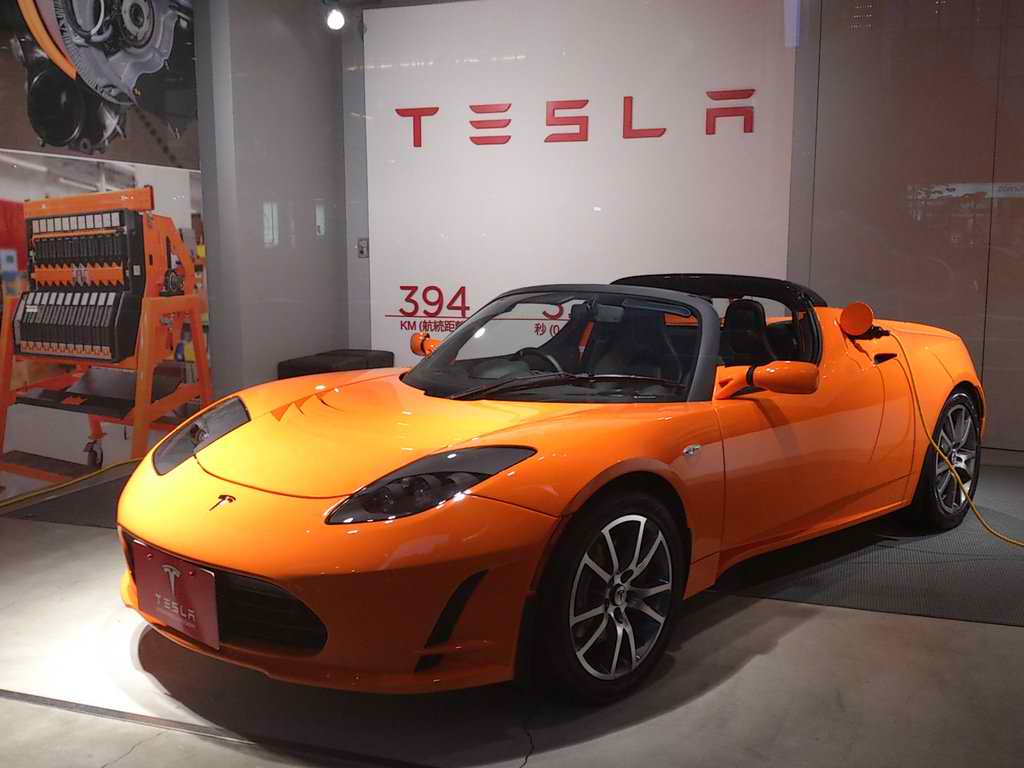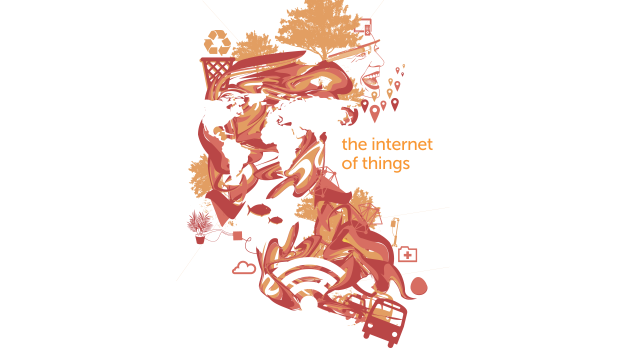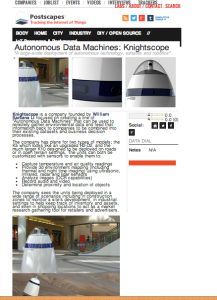Just arrived @ Wearables + Things conference (I’ll speak on “Smart Aging” tomorrow). Hmm: there’s one noteworthy player absent from the conference: those guys from Cupertino. Wonder why they’re not there (perhaps in stealth mode??)
Conference already underway, about to have 2 new product reveals!
- iStrategyLabs, “Dorothy,” connects your shoe to your phone. You’re stuck in a conversation, need way to leave. What if you could click your heels together three times (get it, Dorothy???) and you’d get a bail-out call (or you can trigger an IFTTT recipe or call for a pizza…). “Ruby” goes in shoe. OK, this ain’t as significant as either the Lechal haptic shoe, but who knows how it might evolve…
- Atlas Wearables’ fitness product, Atlas. Their goals is seamless, frictionless experiences. “What if device could recognize specific motions you’re making?” This is really cool: it recognizes and records a wide range of fitness activities, such as push-ups. I really don’t like fact that my Jawbone can’t do that, so this looks good!
Sony Mobile, Kristian Tarnhed. Challenges:
- g data overload. They have a “lifelog” app that tries to make sense of all the data.
- too many devices that want your attention. Make them complement smart phone as much as possible.
- is it really wearable, usable?
Very funny: no one mentions Apple. 10-ton gorilla in the room????
Amazing preso by Jim McKeeth: “Is Thought the Future of Wearable Input?” Guy wearing Google Glass is controlling a drone! Wouldn’t that be an incredible thing for “Smart Aging” to allow a frail elder to control various household things just by thinking them?
Oren Michels, chief strategist, Intel (he was an API pioneer at Mashery):
- APIs make connections. The Epocrates platform from Athena Health is an example: may save $3.5B.
- Also working in travel. Example is Sabre, which has switched to an open API.
- APIs create better customer experiences: Apple Pay! 30% of Starbucks revenue from its phone purchase app.
Quick time to market: Coke was able to restock vending machines instantly during 2012 Olympics through API.
- Examples:
- better healthcare monitoring: give small devices processing power through cloud
- connected car ecosystem (BMW iConnected Services, MyCityWay, TomTom’s WebFleet)
- Snapshot from Progressive
- Inrix — “data for planning smart cities”
This, IMHO, is sooo important: open APIs are great example of my Essential Truth of “who else can use this data?” — you don’t have to develop every kewl use for your device yourself: open the API and others will help!
Peter Li, Atlas Wearables (the company that debuted their new device yesterday):
- iPhone: remember, it was a 3-in-one solution.
- sensors now commoditized: cheap & tiny
- he was a biomedical engineer
- synergistic benefits by combining data streams
- era of augmentation: making you better without you having to think about it.
- frictionless actions
“sensors root of the revolution”
Brad Wilkins, Nike science director:
- he’s exercise physiologist
- they have whole detailed process to understand physiological phenomena. Role of sensor is the describe the phenomena. Then apply that data to enhance athlete potential
Noble Ackerson, Lynxfit, “Hacking Your Way Through Rehab With Wearables”
- they let content publishers (they work with Stanford Health, UnderArmour, etc.) in rehab area to push info to devices. Prescribe workouts. Device agnostic.
- They’ve imported 65 different activities into program.
- Track: heart rate, pace, position, speed, endurance, breathing, sentiment.
Panel: Jim Kohlenberger, JK Strategies; Jose Garcia, Samsung; Mark Hanson, BeClose; Alison Remsen, Mobile Future:
- BeClose is working with seniors!!
- Samsung working with airports to make flying experience more enjoyable.
- BeClose: take some of burden off health care system.
- how government can help: faster networks. “First, do no harm.” — Digital Hypocratic Oath.
DHS (sorry, didn’t get his name):
- In a crisis, “data must inform at the speed of thought” Brilliant
- To be operational, data must be intuitive, instinctive, interoperable, and wearable.
- Creating “Next Generation First Responder”
- Creating fire jackets with sensors built in.
Proximity-aware apps using iBeacon:
- beacons are Bluetooth v4.0 Low Energy transmitters.
- mobiles can identify and determine proximity to beacon: usual range is 25 to 40 m, but you can tune it to much shorter range.
- beacons broadcast unique identifier for the place. Also provide Measured Power Value: what’s signal strength of beacon at specific distance.
- the beacon only sends out a unique identifier, which triggers the app contains all the info that drives the experience.
- app is notified whether you’re in immediate range, near, or far range (might even want to present content when person exits the area).
- beacons protect privacy by being opt-in. They are transmit only: don’t receive or collect signals from mobile devices.
- Apple requires that the app specifically ask user to allow proximity-aware mobile app to access their location.
- non iBeacon versions: AltBeacon (Radius Network’s opsolves en source alternative), and other ones that specific companies will introduce, optimized for their products.
- Radius multi-beacon: solves fragmentation problem or multiple, incompatible beacon ad types. Their RadBeacons handle both types.
- RadBeacon: USB powered, coin-cell battery powered, AA battery powered. Most beacons will only last about a month before battery change.
- Future of beacons: will be split in market: corporate (one of their questions has rolled out more than 16,000 — they won’t powered or long-battery-life versions & remote monitoring) vs. consumers (cheap & disposable). Will be integrated into equipment (wifi access-point hotspots, POS terminals, fuel dispensers, self-service kiosks.
My presentation about “Smart Aging”
Privacy & Security Panel:
- There is real risk of personal data being intercepted. “No perfect solutions.”
- Data can be stored on smart phone OR uploaded to cloud. What control does user have? What if you have health wearable that sends info on blood pressure, etc., to cloud, where it gets shared with companies, and, for example, it can link data to your Facebook data, could be risk of disclosure.
- HIPPA and variety of other regulations can come into play.
- Things moving very quickly, data captured & used. Example of Jawbone data from people who were sleeping during California quake: users upset because the data was disclosed to news media — even though it was just aggregated, was creepy!
- FTC went after the Android flashlight app that was aggregating data. A no-no.
- have to make it simple to understand in statements about how your data will be collected & used.
- Tiles: if the device is gone from home, will send alert to ALL Tile devices. You might be able to modify the software so you (bad guy) could retrieve it it while the owner would think it was still lost. Stalker might even be able to use this data..
Scott Amyx, Amyx & McKinsey, “The Internet of Things Will Disrupt Everything”:
- Example of McLean, the developer of intermodal shipping container. Hmm: does Amyx know about how Freight Farms has created IoT-enhanced food growing in freight containers???
- future of M2M will allow sensors with embedded processors — smarter than today’s computers.
- memory: over time, memory will only grow.
- wifi: most locked networks are idle most of day. Harness them.
- lifi: 2-way network to turn any light as a network. Higher-speed than wifi.
- mesh networks (long-time fascination of mine, especially in disasters): every node creates more powerful network. Can’t be controlled by a central gov.
- Implications:
- can disrupt telecom (mesh networks)
- shifting consumer data from cloud to you
- they’re testing a system that would tell what a person really feels while they’re in store, film companies can test from pilot whether people will really like it. Creepy??
- working with Element to bring this to fashion show: would gauge reaction.
- IoT won’t be great leap, but gradual trend (like my argument that companies should begin with IoT by using it to optimize current manufacturing).
- incredible vision of how you’ll drive to a biz appt. in driverless car, you’ll get briefing on the meeting from your windshield.
- opportunities at every stage of the IoT development shift.




